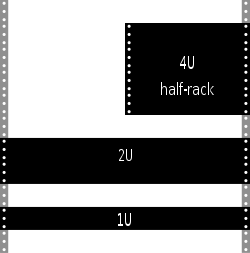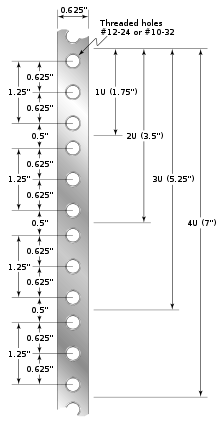Rack unit


A rack unit (abbreviated U or RU) is a unit of measure defined as 1.75 inches (44.45 mm). It is most frequently used as a measurement of the overall height of 19-inch and 23-inch rack frames, as well as the height of equipment that mounts in these frames, whereby the height of the frame or equipment is expressed as multiples of rack units. For example, a typical full-size rack cage is 42U high, while equipment is typically 1U, 2U, 3U, or 4U high.
Coincidentally, 1U is exactly equal to 1 vershok, an obsolete Russian measure of length.
Configurations
A typical full size rack is 42U,[1] which means it holds just over 6 feet (1.8 m) of equipment, and a typical "half-height" rack would be 18–22U, or around 3 feet (0.91 m) high.
The term "half-rack" can have different separate meanings:
- It can describe equipment that fits in a certain number of rack units, but occupy only half the width of a 19-inch rack (9.5 inches (241.30 mm)). These are commonly used when a piece of equipment does not require full rack width, but may require more than 1U of height. For example, a "4U half-rack" DVCAM deck would occupy 4U (7 in) height × 9.5 in width, and in theory, two 4U half-rack decks could be mounted side by side and occupy the 4U space.
- It can also describe a unit that is 1U high and half the depth of a 4-post rack (such as a network switch, router, KVM switch, or server), such that two units can be mounted in 1U of space (one mounted at the front of the rack and one at the rear).
- When used to describe the rack enclosure itself, the term "half-rack" typically means a rack enclosure that is half the height (22U tall).
A front panel or filler panel in a rack is not an exact multiple of 1.75 inches (44.45 mm). To allow space between adjacent rack-mounted components, a panel is 1⁄32 inch (0.031 inch or 0.79 mm) less in height than the full number of rack units would imply. Thus, a 1U front panel would be 1.719 inches (43.66 mm) high. If n is number of rack units, the formula for panel height is h = (1.750n − 0.031) for calculating in inches, and h = (44.45n − 0.79) for calculating in mm.
The rack unit size is based on a standard rack specification as defined in EIA-310. The Eurocard specifies a standard rack unit as the unit of height; it also defines a similar unit, horizontal pitch (HP), used to measure the width of rack-mounted equipment.
The mounting-hole distance (as shown to the right) differs for 19-inch racks and 23-inch racks: The 19-inch racks uses uneven spacings (as shown to the right) while the 23-inch racks uses evenly spaced mounting holes.
Although it is called a 19-inch rack unit, the actual mounting dimensions of a 19-inch rack unit are 18.312 inches (465 mm)[2] wide, center to center.
Rack units are universally the same, but the type of thread[3] can vary depending on the rack. Mounting rails can be No. 10-32 tapped (Unified Thread Standard), No. 12-24 tapped, metric M6 threaded or universal square holes. Universal square holes are becoming the most common as these allow the insertion of replaceable cage nuts for the type of thread needed. This prevents stripping of the threading on the rails and allows for more flexibility.
| Rack unit | inches | mm |
|---|---|---|
| 1U | 1.75 | 44.45 |
| 2U | 3.5 | 88.9 |
| 3U | 5.25 | 133.35 |
| 4U | 7.0 | 177.8 |
| 5U | 8.75 | 222.25 |
| 6U | 10.5 | 266.70 |
| 7U | 12.25 | 311.15 |
| 8U | 14.0 | 355.6 |
| 9U | 15.75 | 400.05 |
| 10U | 17.5 | 444.5 |
| 11U | 19.25 | 488.95 |
| 12U | 21.0 | 533.40 |
| 13U | 22.75 | 577.85 |
| 14U | 24.5 | 622.30 |
| 15U | 26.25 | 666.75 |
| 16U | 28.0 | 711.2 |
| 17U | 29.75 | 755.65 |
| 18U | 31.5 | 800.1 |
| 19U | 33.25 | 844.55 |
| 20U | 35.0 | 889.0 |
| 21U | 36.75 | 933.45 |
| 22U | 38.5 | 977.90 |
| 23U | 40.25 | 1022.35 |
| 24U | 42.0 | 1066.80 |
| 25U | 43.75 | 1111.25 |
| 26U | 45.5 | 1155.7 |
| 27U | 47.25 | 1200.15 |
| 28U | 49.0 | 1244.60 |
| 29U | 50.75 | 1289.05 |
| 30U | 52.5 | 1333.5 |
| 31U | 54.25 | 1377.95 |
| 32U | 56.0 | 1422.4 |
| 33U | 57.75 | 1466.85 |
| 34U | 59.5 | 1511.30 |
| 35U | 61.25 | 1555.75 |
| 36U | 63.0 | 1600.2 |
| 37U | 64.75 | 1644.65 |
| 38U | 66.5 | 1689.10 |
| 39U | 68.25 | 1733.55 |
| 40U | 70.0 | 1778.0 |
| 41U | 71.75 | 1822.45 |
| 42U | 73.5 | 1866.9 |